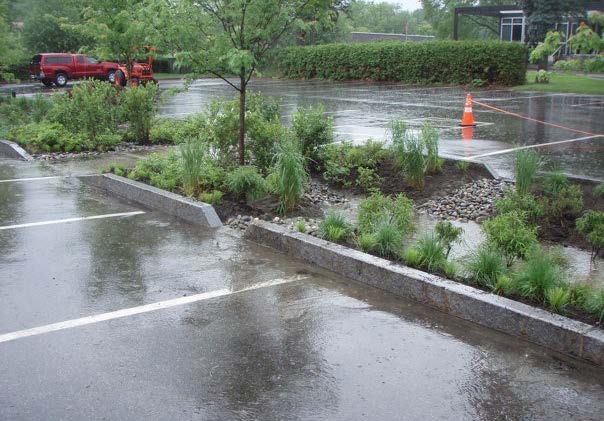Summary of the Lake Champlain Phosphorus Management Plan
Jun. 23rd 2015Lake Champlain is treasured by Vermonters as a place for recreation, a source of drinking water, and a place for economic opportunity. However, Lake Champlain health has been of concern for many years. A major cause of problems in Lake Champlain is excess phosphorus, which can lead to excess of growth of algae. Blue-green algae blooms, which are common occurrences during the summer months and can sometimes be toxic, can result in public health problems, fish kills, and loss of habitat for many organisms.


Sources of excess phosphorus include both point and non-point sources from agricultural, forest, developed, and riverine lands. Phosphorus from each of these sources differs, and future inputs could be affected by climate change and the possibility of more extreme storm events.
The State of Vermont has developed strategies to reduce phosphorus inputs from each of the sources using a Total Maximum Daily Load (TMDL) plan. The plan is in the first phase, which is focused on basin-wide implementations to reduce nonpoint source phosphorus inputs. Regulatory measures, funding and financial incentives, and technical assistance to landowners to meet the regulatory requirements are all a part of the plan to reach the goals of reducing phosphorus inputs.
Point source pollution, primarily from wastewater treatment plants and stormwater discharge, will not be the focus of reduction strategies as regulations are already in place. Non-point sources will be the target of efforts for reducing phosphorus inputs.
Seven land sectors are being targeted for management and phosphorus reduction: stormwater, transportation, agriculture, forestry, river and floodplains, wetlands, and shorelands. To implement this reduction, the state will work with landowners, towns, and state departments to develop regulations and provide assistance, both technical and financial, to disseminate information and assist with appropriate actions. Continued monitoring and assessment is also a part of the plan to track progress.
| Permitting and regulating | Infrastructure and maintenance needs | Training and education opportunities | Grants and incentive programs available | |
| Developed lands- stormwater | Impervious, construction, industrial permits, MS4 permitting | Runoff controls, green stormwater infrastructure | Support municipalities | |
| Developed lands - transportation | Adoption of state standards by municipalities | Better Backroads recommendations for maintenance | Cost share funds for municipalities adopting state standards | |
| Agriculture | Nutrient management plans, regular inspections, medium and large farm permits | Fences, buffers, gully prevention | Manure application, tile drain management, technical assistance for Accepted Agricultural Practices with Agricultural Resource Specialists, land treatment plans and nutrient management plans with Land Treatment Planners, assistance and information from UVM Extension | Targeted support to northern and southern segments, federal and state incentive programs for best management practices, buffers, and nutrients |
| Forestry | Heavy Cutting law and Acceptable Management Practices | Logging skidder tracks | Support forest conservation, "climate-smart" adaptation strategies | MOU between forestry industry and Department of Forest, Parks, and Recreation during potential discharge periods |
| River and floodplains | Compliance with Act 250 regulations, moderation of streamflow and reservoir levels | Increase protection and restoration, floodplain management | Flood Ready website, support municipalities prior to and during flood emergencies, many outreach and education programs from state and partners for communities and landowners | Support cities and towns for floodplain and corridor standards, FEMA pre-disaster mitigation funds for communities |
| Wetlands | Classified wetlands are protected and regulated under Act 31 | Restoration projects | Support from VT ANR for communities and landowners | Federal, state, and local opportunities for financial inventives towards wetland conservation and restoration |
| Shorelands | Municipal regulation | Vegetated stabilization | Outreach and assistance to landowners through Lake Wise program, assistance to towns to implement municipal measures | Grants available through Regional Planning Commissions for vegetated stabilization |
The first phase of this plan is scheduled to take twenty years for full implementation, with many benchmarks along the way. Future plans for further implementation will focus on the contributions by each land sector (i.e. forest land, agricultural land), calculating the contribution from each of five subbasins of the lake. Each subbasin has different primary inputs and loading capacities, or the amount of phosphorus that it can absorb without negative implications. The goal is to reduce phosphorus inputs to fall within the limits of what the lake can handle. By focusing on the subbasins, a better strategic plan for reducing phosphorus inputs can be developed, targeting the problem areas and sources specific to that subbasin.
In addition to the plan developed by the State for the U.S. Environmental Protection Agency, the Vermont State Legislature also passed a bill, H.35, in support of improving the quality of waters of Vermont using the TMDL plan and with a plan for funding the improvements. H.35 was signed into law by Governor Shumlin on June 16, 2015.
 ecoNEWS VT
ecoNEWS VT